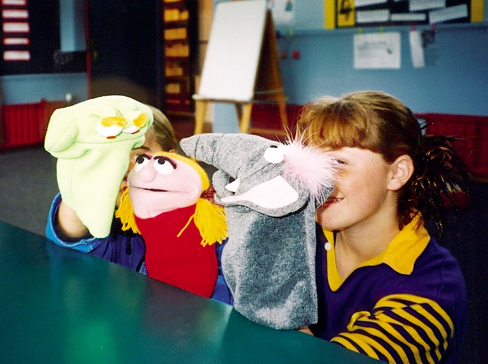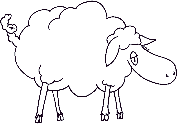Although national monitoring has been designed primarily to present an overall national picture of student achievement, there is some provision for reporting on performance differences among subgroups of the sample. Seven demographic variables are available for creating subgroups, with students divided into two or three subgroups on each variable, as detailed in Chapter 1.
The analyses of the relative performance of subgroups used an overall score for each task, created by adding scores for the most important components of the task.
Where only two subgroups were compared, differences in task performance between the two subgroups were checked for statistical significance using t-tests. Where three subgroups were compared, one way analysis of variance was used to check for statistically significant differences among the three subgroups.
 Because
the number of students included in each analysis was quite large (approximately
450), the statistical tests were quite sensitive to small differences.
To reduce the likelihood of attention being drawn to unimportant differences,
the critical level for statistical significance was set at p = .01 (so
that differences this large or larger among the subgroups would not be
expected by chance in more than one percent of cases). The critical level
was adjusted to p = .05 for the two tasks where differences in team performance
among 120 teams were being examined.
Because
the number of students included in each analysis was quite large (approximately
450), the statistical tests were quite sensitive to small differences.
To reduce the likelihood of attention being drawn to unimportant differences,
the critical level for statistical significance was set at p = .01 (so
that differences this large or larger among the subgroups would not be
expected by chance in more than one percent of cases). The critical level
was adjusted to p = .05 for the two tasks where differences in team performance
among 120 teams were being examined.
For the first three of the seven demographic variables, statistically significant differences among the subgroups were found on less than 15 percent of the tasks. For the remaining four variables, statistically significant differences were found on higher percentages of tasks. Details are presented below.
School
size
Results were compared from students in larger, medium sized, and small
schools (exact definitions were given in Chapter
1). For year 4 students, there were differences among the three subgroups
on 1 of the 17 reading tasks and none of the 15 speaking tasks. Students
from medium sized schools scored lowest on Cats'
Eyes. There were no differences on questions of the Year
4 Reading and Speaking Survey.
For year 8 students, there were differences among the three subgroups on none of the 19 reading tasks and 1 of the 16 speaking tasks. Students from small schools scored highest and students from large schools lowest on Puppet Play. There were no differences on questions of the Year 8 Reading and Speaking Survey.
 School
type
School
type
Results were compared for year 8 students attending full primary schools
and year 8 students attending intermediate schools. There were differences
between the two subgroups on 1 of the 19 reading tasks and 1 of the 16
speaking tasks. Students from intermediate schools scored lower on Reading
Record Fiction (p17) and Puppet Play (p54). There were no differences
on questions of the Year 8 Reading and Speaking Survey.
Community
size
Results were compared for students living in communities containing over
100,000 people (main centres), communities containing 10,000 to 100,000
people (provincial cities), and communities containing less than 10,000
people (rural areas).
For year 4 students, there were differences among the three subgroups on 1 of the 17 reading tasks and 2 of the 15 speaking tasks. Students from rural areas scored lowest on Signs Around Town, Talk Time, and Link Task 11. There were no differences on questions of the Year 4 Reading and Speaking Survey.
For year 8 students, there were differences among the three subgroups on 1 of the 19 reading tasks and 1 of the 16 speaking tasks. Students from rural areas scored highest on Stories in Mäori and students from main centres scored lowest on Link Task 8. There were differences on two questions of the Year 8 Reading and Speaking Survey. Students from the main centres were least positive about their parents' views of their reading (question 4) but said they most often read to others at school (question 7).
Zone
Results achieved by students from Auckland, the rest of the North Island,
and the South Island were compared.
For year 4 students, there were differences among the three subgroups on 2 of the 17 reading tasks and 3 of the 15 speaking tasks. Students from the South Island scored highest on four of the five tasks, with students from the rest of the North Island lowest on four of the five tasks. These tasks were Reading Record Non-Book, An Elephant Story, Three Woolly Lambs, Link Task 7, and Talk Time. There were no differences on questions of the Year 4 Reading and Speaking Survey.
For year 8 students, there were differences among the three subgroups on 5 of the 19 reading tasks and 3 of the 16 speaking tasks. Students from the South Island scored lowest on the two Mäori reading tasks: Stories in Mäori and Link Task 1. However, South Island students scored highest on Cats' Eyes, Link Task 2, Language of Poetry and Statues. Students from Auckland scored lowest on Link Task 8, and students from the rest of the North Island scored highest on Talk Topics. There were no differences on questions of the Year 8 Reading and Speaking Survey.
Gender
Results achieved by male and female students were compared.
For year 4 students, there were differences between boys and girls on 9 of the 17 reading tasks and 7 of 13 speaking tasks. Girls scored higher in all cases. Because of the large number of tasks involved, they will not be listed here. Girls also gave more positive ratings than boys on 8 questions of the Year 4 Reading and Speaking Survey. They reported greater enjoyment of reading at school (question 1) and in their own time (question 8), believed they were better at reading (question 2), and believed their parents thought they were better at reading (question 4). They also were more positive about receiving a book as a present (question 9), going to a library (question 11), and reading out loud to their teacher (question 16) or to the class (question 17).
For year 8 students, there were differences between boys and girls on 2 of the 19 reading tasks and 2 of 14 speaking tasks. Girls scored higher on all four tasks: Stories in Mäori, Garage Sale, Dial 111, and Link Task 10. Girls also gave more positive ratings than boys on 6 questions of the Year 8 Reading and Speaking Survey. They reported greater enjoyment of reading in their own time (question 8), believed their parents thought they were better at reading (question 4), and said they got more positive feedback from their teachers (question 5). They also were more positive about receiving a book as a present (question 9), going to a library (question 11), and the books they read in the school reading programme (question 12).
Student
ethnicity
Results achieved by Mäori and non-Mäori students were compared.
This was possible for only about half of the speaking tasks because ethnicity
could not be identified where tasks were performed by teams or by individuals
within teams.
In year 4, Mäori students scored higher than non-Mäori students on one of the two tasks that involved reading in Mäori (Stories in Mäori), and there was no difference on the other task (Link Task 1). Mäori students scored lower than non-Mäori students on 15 of the remaining 16 reading tasks and 4 of 6 speaking tasks. The three tasks on which differences were not found were Favourite Book, Link Task 8, and Link Task 10. The latter two involved Mäori contexts. Mäori students gave more positive ratings than non-Mäori students on one question of the Year 4 Reading and Speaking Survey: how much they enjoyed going to a library (question 11).
In year 8, Mäori students scored higher than non-Mäori students on both tasks that involved reading in Mäori: Stories in Mäori and Link Task 1. Mäori students scored lower than non-Mäori students on 9 of the remaining 17 reading tasks, and 3 of the 7 speaking tasks: Reading Record Non-Fiction, Cats' Eyes, An Elephant Story, Garage Sale, Journey of a Letter, Link Task 2, Link Task 3, Favourite Book, Language of Poetry, News, The Sandwich, and Wishing Ring. Non-Mäori students gave more positive ratings than Mäori students on one question of the Year 8 Reading and Speaking Survey: how much they liked reading in their own time (question 8).
Socio-economic
index
Schools are categorised by the Ministry of Education based on census data
for the census mesh blocks where children attending the schools live.
The SES index takes into account household income levels, categories of
employment, and the ethnic mix in the census mesh blocks. The SES index
uses ten subdivisions, each containing ten percent of schools (deciles
1 to 10). For our purposes, the bottom three deciles (1-3) formed the
low SES group, the middle four deciles (4-7) formed the medium SES group,
and the top three deciles (8-10) formed the high SES group. Results were
compared for students attending schools in each of these three SES groups.
For year 4 students, there were differences among the three subgroups on 15 of the 17 reading tasks and 13 of the 15 speaking tasks. In each case, students from low SES schools scored lowest. While students from high SES schools generally did better than students from medium SES schools, these differences were usually smaller than the differences between students from low and medium SES schools. The four tasks on which differences were not found were Stories in Mäori, Link Task 1, Special Visitor, and Link Task 10. These included the two tasks that involved reading in Mäori. There were also differences on two questions of the Year 4 Reading and Speaking Survey. Students from low SES schools indicated that they received more advice from their teacher on how to improve their reading (question 6), and were more positive about going to a library (question 11).
For year 8 students, there were differences among the three subgroups on 11 of the 19 reading tasks and 9 of the 16 speaking tasks. Students from low SES schools scored highest on the two tasks that involved reading in Mäori: Stories in Mäori and Link Task 1. On the other 9 reading tasks and all 9 speaking tasks for which differences were found, students from high SES schools generally scored better than students from medium SES schools, who in turn generally scored better than students from low SES schools. Because of the number of tasks, they will not be listed here. There were differences on three questions of the Year 8 Reading and Speaking Survey. Students from low SES schools indicated that they received more feedback from their teachers about the strengths of their reading (question 5), received more advice from their teachers on how to improve their reading (question 6), and were more positive about going to a library (question 11).
![]()
Summary
School size, community size, and school type (full primary or intermediate)
did not seem to be important factors predicting achievement on reading
and speaking tasks. Students from the South Island scored highest on 12
percent of the tasks at both year levels, but were lowest on the two Mäori
reading tasks. At year 4 level, girls performed better than boys on 53
percent of the reading and speaking tasks and recorded more positive responses
on 8 reading survey questions. At year 8 level, the advantage of girls
over boys had dropped to 12 percent of the reading and speaking tasks,
but they still recorded more positive responses on 6 reading survey questions.
Non-Mäori year
4 students performed better than Mäori year 4 students on 94 percent
of the English language reading tasks and 67 percent of the speaking tasks.
The corresponding figures for year 8 students were 53 percent of reading
tasks and 43 percent of speaking tasks. Year 8 Mäori students scored
higher on both Mäori language reading tasks. There were differences
between the three SES (decile) subgroups for 88 percent of the reading
and speaking tasks at year 4 level, dropping to 57 percent at year 8 level.
Students from low decile schools generally scored lowest. Given the importance
of reading in other aspects of the school curriculum and in life in our
community, these patterns must be of concern. It is encouraging, however,
to note the improvement from year 4 to year 8, and that lower performance
on tasks did not generally seem to be accompanied by negative attitudes
to reading and speaking activities in school and beyond.